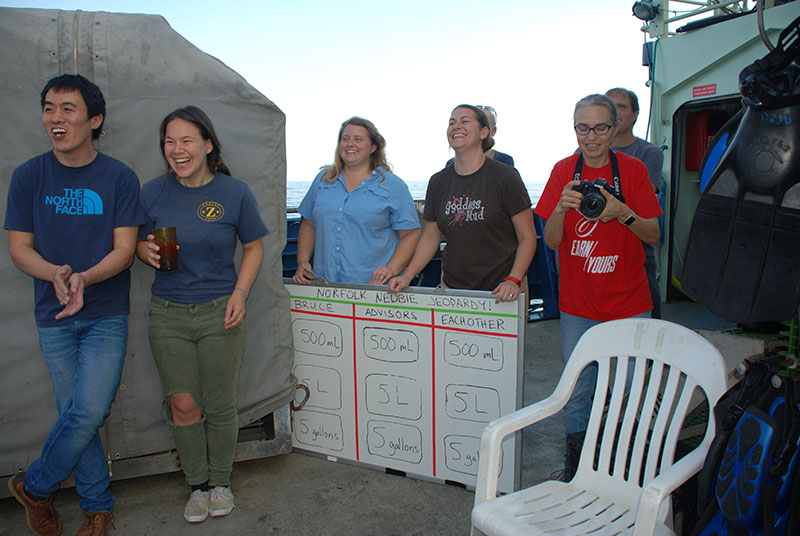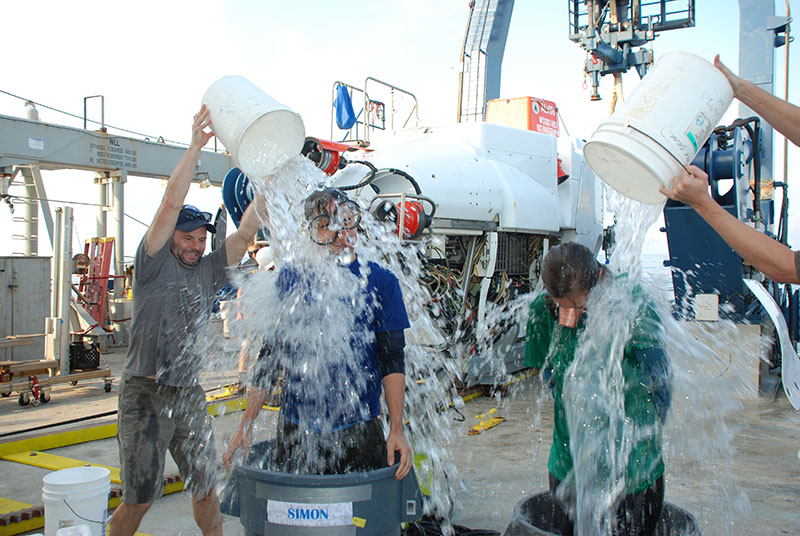
By Caitlin Adams, Web Coordinator, NOAA Office of Ocean Exploration and Research
September 1, 2018
On the last day of August 2018, the DEEP SEARCH team had its last Alvin dive of the cruise. The eleventh, final dive saw two newbies in the sub: first-year Cordes Lab grad student Ryan Gasbarro and Joye Lab research technician Lauren Carroll both got to experience Alvin for the first time. They rode with veteran pilot Bruce Strickrott 1,900 meters down into Norfolk Canyon, about 30 miles offshore Virginia. They collected a variety of corals in the quivers and biobox, including a few species we hadn’t yet collected, as well as 24 more pushcores for the mud teams.
When Lauren and Ryan arrived back on deck, they were greeted with the most elaborate initiation ceremony of the cruise: costumes in homage to Alvin and the Chipmunks and a trivia game where the difficulty of the question was measured in water volume—get it right and your partner gets the water, get it wrong and you get it. In no time, both were fully doused but all smiles; it was the perfect note to go out on for all involved.

First-time Alvin divers Ryan Gasbarro and Lauren Carroll were given costumes made with supplies easily found around the lab—Styrofoam cups, rubber bands, and sediment core rings. Image courtesy of DEEP SEARCH 2018 - BOEM, USGS, NOAA. Download larger version (jpg, 4.8 MB).

Team DEEP SEARCH looks on as Ryan and Lauren carefully make their selections from an ice-bath-themed trivia board. Image courtesy of DEEP SEARCH 2018 - BOEM, USGS, NOAA. Download larger version (jpg, 4 MB).

Ryan Gasbarro gets fully dunked by his PhD advisor Erik Cordes. Image courtesy of DEEP SEARCH 2018 - BOEM, USGS, NOAA. Download larger version (jpg, 4.6 MB).
Just because our dives were over yesterday does not mean the work is over though—not in the least. Immediately after the Alvin samples were secured on deck and everyone had the chance to grab a quick dinner, we completed two more CTD casts, one for a full depth profile and the other to collect cold seawater to refresh the tanks of live corals we have onboard. It takes four people to deploy and run each CTD cast and another four to collect all of the water once it’s back on deck—not to mention all the time filtering and sampling from each bottle.

HOV Alvin is recovered onto the deck for the last time during DEEP SEARCH. Image courtesy of DEEP SEARCH 2018 - BOEM, USGS, NOAA. Download larger version (jpg, 4.2 MB).
After the CTD casts, the ship got underway for our nearly 33-hour transit north to port in Woods Hole, Massachusetts. While we’re transiting, the mud teams will be processing all of the cores from the last dive, the coral scientists will sample and store the last collections, and we’ll all begin the packing process. It takes a massive amount of gear to get all of the work done we’ve accomplished over the past two weeks, and now each lab must face the daunting task of repacking, shipping, and storing all of the supplies and samples onboard. Both Erik Cordes and Mandy Joye will be out on the R/V Atlantis later this year for separate cruises, so they get the extra fun task of figuring out exactly what they want to leave in a shipping container at Woods Hole for their next adventures and what actually needs to make it home with them right now.

After the last dive of the cruise, the Alvin team removes all of the paneling and gives the submersible a thorough cleaning. They will also run a series of tests and maintenance once we return to port, as they do at least once every 30 dives. Image courtesy of DEEP SEARCH 2018 - BOEM, USGS, NOAA. Download larger version (jpg, 4.3 MB).
As the labs are slowly cleared of equipment and samples and our cabins are packed, we’ll go through and clean everything as well—the ultimate goal of any research cruise is to the leave the ship in the condition you found it. The crew of the R/V Atlantis and the Alvin team have been nothing but absolutely wonderful to us out here, and we want to make sure we don’t leave behind extra work for them to do, as they have their own lengthy to-do lists to check off as we head to port.
When we arrive in port tomorrow, a number of us will be heading out to catch flights home, but many more will be staying behind for a couple days, ensuring that everything makes it off the ship and on its way back to a scientist’s lab. We’ve spent two weeks out here collecting samples and data, and now the DEEP SEARCH team will spend far longer than that making sense of all we’ve collected and seen.